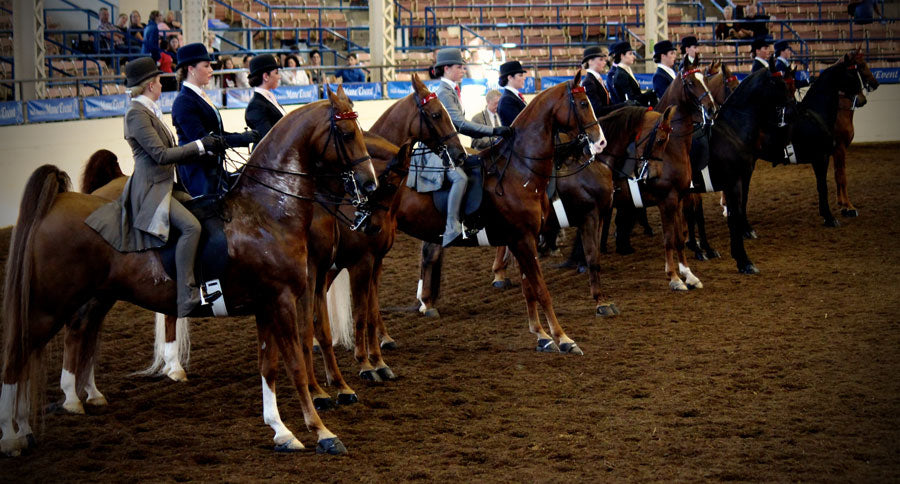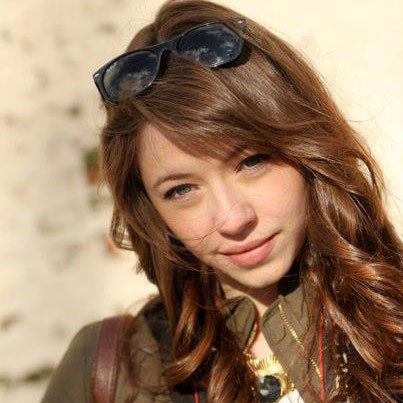A Beginner's Guide to a Saddlebred Horse Show May 19 2015 9 Comments

Being in the Saddle Seat industry, it can be really hard to explain why we love our sport so much. But the struggle is even more real for horse show newbies. For them, it can be borderline impossible to actually turn up to a horse show and figure out what’s going on.
How did they decide who won that class? Why are people yelling? And what’s with the organ music?
Riding disciplines like racing and jumping can be fairly easy to understand from a spectator’s point of view; cross the finish line first, or go over all the jumps fastest, and you win the ribbon. Saddle Seat, however, is a different beast entirely! There are so many different divisions to figure out. You don’t win if you are the fastest, you don’t win if you jump the highest, and even if there is a pattern to do, there’s also a rail work portion to figure out.
So, with all that said, here is quick beginner's guide to Saddle Seat horse shows, with questions provided by Tom the horse-show-neophyte.
When I watch a class, what should I be looking out for? What’s good horse form look like? And what does bad horse form look like?
Generally speaking, at a saddle seat show, you want to see a look of ease. Each division asks for different specifics - things like five gaits instead of three, a pattern, or showing at the flat walk or halt.
However, generally speaking, the most attractive horse with the most clear look of ease in the horse AND rider is the one that’s going to take the cake. These horses love their jobs and even if their riders are working really hard to keep their horse contained when it wants to leap for joy, the idea is that the rider also looks like they love their job! Equestrians everywhere have heard it before: “riding isn’t even hard, you just sit there” well in saddle seat (a sport in which that is not even REMOTELY true), that can be taken as very high praise!

What kinds of classes are more about the rider than the horse? What should I be looking for in those classes? What’s good riding form look like? What does bad riding form look like?
Equitation classes are more about the rider than the horse. Equitation also has a variety of sub classes - i.e. pleasure equitation, saddle seat equitation, adult equitation, etc. In a class like this, you want to see great posture! Nothing absurd or crazy, but great posture just like you’d observe in someone walking around the city, upward gaze, shoulders down and back with clean confidence in their movement. This of course does not mean stiffness. Just like with good posture in life, stiffness is not only uncomfortable, but it is also uncomfortable to look at. The only thing that’s really different in saddle seat is the leg position. An easy thing to remember for new spectators is that there should be a straight line from the competitors shoulders, down to their hips, down to the back of their heels.
In classes where it’s all about the horse, won’t the most expensive horses just end up winning?
While financial investment plays a role in all equestrian sports, as well as all sports that rely heavily on “equipment” (in this case a beloved equine partner), behavior and riding ability has a huge effect on whether or not a horse can perform at its best. Depending on the division, a horse that costs well into the six figures may not be able to win a single ribbon simply because that horse does not like to flat walk or halt. If classes are large and there are a number of quality exhibitors that have great rides, if the most expensive horse in the class ends up buried by its competitors, it could easily be overlooked by the judges for a far less expensive horse that has a rider with ring sense/more showmanship. There are a number of factors that play into how well a horse does in any given day, but having the most expensive horse does not buy you a ribbons!
How about the classes in buggies? How are they judged?
Classes with jog carts or fine harness carts are typically pleasure and are judged by the same standards as other performance divisions. The horse that looks the happiest, that performs their required gates, and is seen by the judges will be the winner!
What are all those people in the stands yelling about?
As my Aunt Phoebe said at her first experience of a saddle seat show, “What is this? A tourettes convention?” The intermittent yelling and screaming of phrases like “YA BOY” and “YEEEEW” are just examples of some of the things you might be startled by at a saddle seat show. The reasoning behind this behavior is really quite simple: the horses they are yelling for are show horses and they LOVE to feel the crowd appreciating them. There’s nothing like crowd support to make a horse get bigger in mind and body than you’ve ever felt before! They love attention, they love to be admired, and cheering is the easiest way for them to understand you, as the audience, are appreciating their beauty! So be sure to pick a favorite and let a “ya boyyyyy!” out when you get to your first saddle seat show.
Have any questions about what’s going on at a saddle seat show that we missed? Or can you add anything to the answers we provided? Comment down below!


Comments
Candy Mees on February 02 2019 at 06:04PM
What a pleasure to see these beautiful horses again. I rode saddle seat equitation in the 60’s with Sullivan “Dave” Davis at Hanover Farms in NJ. I love seeing these pictures and, although some of them seem older, I don’t recognize any of the names (except I do remember hearing of Wing Commander back then). Here in NJ, Saddlebreds seem to have disappeared ~ are they more in the south? I also thought tail breaking had been outlawed – has that changed? I’m sure much has changed in the 50 (!) years since I’ve been showing, but one thing remains the same – Saddlebreds are still absolutely beautiful!
Kathie Dunn on March 18 2017 at 08:25AM
For Patricia – It is only a very small percentage of Saddlebreds that gait. And those that do, also trot. That’s why people post. They do have a genetic trait that allows some of them to slow gait and rack, but unlike TWH, are not considered a pure gaited breed. They are a trotting breed that has additional gaits.
Patricia Surratt on November 08 2016 at 02:55AM
I was watching some exhibition tapes and wondering why on earth are the riders posting on gaited horses? Is it just a saddlebred thing, BC I’ve never seen that at a twhbea show. Just a wonder!
Patricia Surratt on November 08 2016 at 02:55AM
I was watching some exhibition tapes and wondering why on earth are the riders posting on gaited horses? Is it just a saddlebred thing, BC I’ve never seen that at a twhbea show. Just a wonder!
Kimberly BLING on March 19 2016 at 06:41AM
Thank you so much for having SADDLE SEAT articles
I see all kinds of stock horse and hunt seat articles. But I can find very little about Saddle Seat. I greatly appreciate everything.
Kimberly BLING
BLING by Design Saddle Seat Neck Ties and Accessories
Lansing, Michigan
D Logan on February 18 2016 at 06:50PM
Thanks for this great, well written article and answered a couple questions that I had. Showing has changed so much from when I did ring work back in the 50’s that I certainly had questions and hadn’t been around folks that I felt I could ask.
CJ Graves on June 04 2015 at 09:10AM
Great article. You should send it out to places like the Virginia Horse Center and others around the country trying to rebuild interest in horse shows. This is the type of information that should be out there and published in other newsletters. Horse showing is not just western, or hunter/jumper. Go Saddleseat!
Sally Lindabury on May 22 2015 at 07:13AM
LOVE all your posts and excellent descriptions of such things as canter departures, etc. keep up the posts with such easily understood explanations. Are you writing a book?
Kalar on May 21 2015 at 07:34PM
Love it!! Thank you!